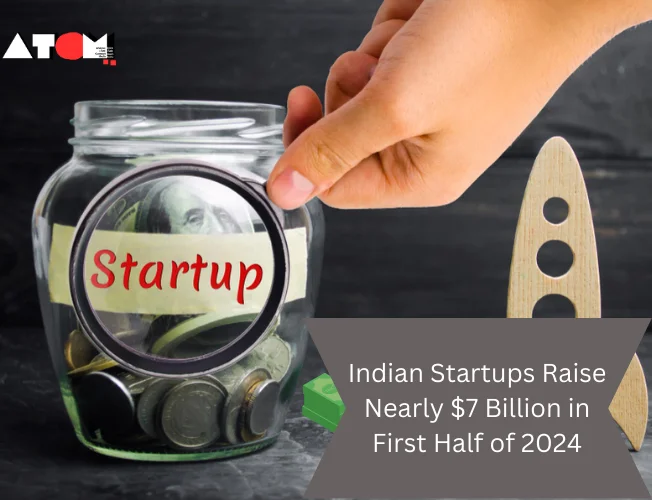The Indian startup scene is still thriving and has shown incredible growth and endurance. Indian companies successfully raised close to $7 billion in funding in the first half (H1) of 2024. While it is still far less than the $20 billion raised in the first half of 2022, this amount is a notable rise over the $5.92 billion raised during the same period last year.
Breakdown of Funding
The funding landscape in H1 2024 is diverse, encompassing various stages of investment. According to data compiled by TheKredible and reported by Entrackr, the $7 billion funding is spread across three primary types of deals:
- Growth or Late-Stage Deals: 182 deals amounting to $5.4 billion.
- Early-Stage Deals: 404 deals totaling $1.54 billion.
- Undisclosed Deals: 99 deals with undisclosed amounts.
This analysis reveals a notable concentration of investment in growth and late-stage firms, which is indicative of investor trust in more established businesses with stable revenue streams and business strategies.
Rise of New Unicorns
The development of new unicorns inside the Indian startup ecosystem is one of the major highlights of H1 2024. During this time, Perfios and Krutrim SI Designs are the two startups that became unicorns. This is a welcome trend, particularly in light of the fact that only two startups achieved unicorn valuations the year before. On the other hand, there were 44 unicorns in 2021 and 26 in 2022, suggesting a cyclical but encouraging pattern in the formation of highly valued firms.
Monthly Funding Trends
Upon examining the monthly patterns, June 2024 emerged as a noteworthy anomaly. Almost $2 billion was funded this month, which is twice as much as the $1 billion on average that was funded each month up until May. This June spike highlights a time of increasing investor activity and financial entry into the Indian startup scene.
Top Funded Startups
Several late-stage startups secured substantial investments, leading the funding charts for H1 2024. These include:
- Zepto: $665 million
- Flipkart: $350 million
- PharmEasy: $216 million
- Lenskart: $200 million
These numbers demonstrate how investors’ interest in and confidence in well-established companies that are developing their businesses and market share is growing.
Mergers and Acquisitions
These numbers demonstrate how investors’ interest in and confidence in well-established companies that are developing their businesses and market share is growing.
Sector-Wise Funding
Some intriguing patterns emerge from a funding analysis broken down by sector. With 124 companies raising more than $1.87 billion, the e-commerce industry took the lead in the funding competition. Substantial investments in other industries, including software as a service (SaaS), healthtech, finance, and electric vehicles (EVs), come after this. EV startups raised more money among them than SaaS and healthtech companies, which is indicative of the increased focus on environmentally friendly and sustainable technology.
On the other hand, financing for industries including proptech, edtech, foodtech, and agritech decreased in H1 2024. This change in direction may be explained by shifting investment inclinations, shifting market conditions, and changing demands from the Indian customer base.
Implications for the Future
The H1 2024 statistics presents a positive image of the Indian startup scene. The large amount of money, especially for growth and late-stage businesses, suggests a healthy investment climate. The rise of unicorns and large funding in important industries such as EVs, fintech, healthtech, and e-commerce point to a promising second half of the year.
Investor Sentiment and Market Dynamics
The mood among investors seems cautiously upbeat. A more deliberate and selective approach to investment is suggested by the decline in mergers and acquisitions. However, the significant capital sums show that there is a great deal of faith in the ability of Indian entrepreneurs to grow and innovate.
Government and Regulatory Support
With programmes like the Startup India Programme, the Indian government still plays a crucial role in fostering the startup environment. Regulations are being changed to make it simpler to obtain capital and lower administrative barriers, creating an atmosphere that is more favourable for the growth of startups. Maintaining the momentum and making sure that entrepreneurs have the infrastructure and resources they need to expand depend heavily on this government backing.
Results
Nearly $7 billion in funding has been raised by Indian companies in the first half of 2024, spanning multiple investment phases. The growing maturity and potential of the Indian startup ecosystem is evidenced by the development of new unicorns and significant funding in strategic sectors. It will be critical to keep an eye on how these patterns change over the year and what fresh chances present themselves for both investors and entrepreneurs.
Future Opportunities and Difficulties
In the future, a number of things will affect how the Indian startup ecosystem develops. These include shifts in investor attitude, the state of the world economy, and startups’ capacity to adjust to changing market conditions. Obstacles including market competitiveness, finance availability, and regulatory compliance will remain important.
However, the fundraising trends and the emergence of new unicorns demonstrate the tenacity of Indian startups, indicating that the ecosystem is well-positioned to overcome these obstacles. Maintaining growth and cultivating a thriving startup scene will be largely dependent on government funding that keeps up and innovation-focused.





